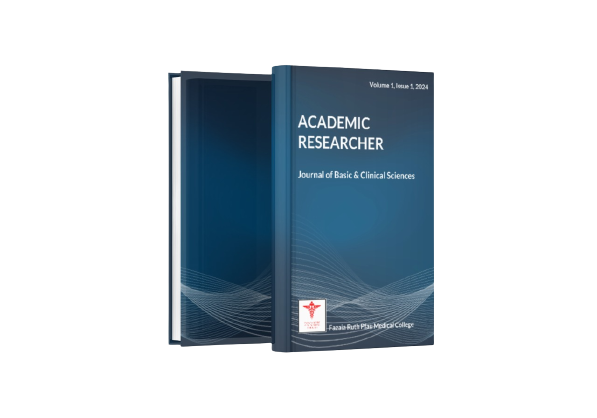

Academic Researcher
Journal of Basic and Clinical Sciences
Volume 01, Issue 02, 2024
An Official Journal of Fazaia Ruth Pfau Medical College, Air University
ISSN: 3008-0495 (Online)
ISSN: 3008-0487 (Print)
A Cross-Sectional Study on Prescription Drug Interactions in Private Pharmacies
Samia Perwaiz Khan, Fatima Noor, Sameena Ahmed, Fatima Kazim, Shajiah Intekhab, Sami Navaid, Aliya Waqar
Acad Res. 2025, 2 (2): 62-69
DOI: https://doi.org/10.70349/ar.v2i1.32
Abstract
Background:
Prescription drug interactions, drug-drug interactions (DDIs), stance a
substantial risk to patient safety, followed by adverse drug reactions (ADRs), treatment letdowns,
and increased healthcare costs. The objective of the study was to determine the frequency of
drug-drug interactions, the intensity and the mechanisms in the prescriptions from
Private Pharmacies, Karachi.
Method:
Data of prescriptions was collected from private pharmacies and outpatient clinics
of tertiary hospital; from September 2023- 2024 by convenience sampling technique
including100 prescriptions. This cross-sectional study included prescriptions from multiple local
pharmacies in Karachi and tertiary care hospital out-patient clinics. The mechanism of
interactions was determined by the interactions chart and Medscape online, along with the type
of DDI interactions. Statistical analysis test was applied for statistical analysis of data, while
95% CI, and p-value is > 0.05. In inferential statistics, the relationship between
independent and dependent variables were analyzed by using simple logistic regression
and multiple logistic regression.
Results:
Out of total of 100 prescriptions, 43% had shown drug-drug interactions, 20% were
minor, 30% moderate and 5% severe. Among these pharmacokinetic were 11%,
pharmacodynamics 26% and unknown 7%. 51. 24%, interactions have pharmacodynamics mechanism, 37.94% have pharmacokinetic and
8% operated through unknown mechanism. Logistic regression age 3.168(95%CI 1.287-
1.800), gender 2.685(95% CI 0.896-4.670), comorbidities 2.046(95%CI 0.896-4.670), Number
of prescribed medications 15.237(4.683-49.579).
Conclusion:
High percentage of moderate interactions were found in 43% of prescriptions. In
terms of mechanism, pharmacodynamic interactions were of the highest in frequency.
Keywords
potential drug-drug interactions, pharmacokinetic drug interactions, pharmacodynamics drug interactions.








